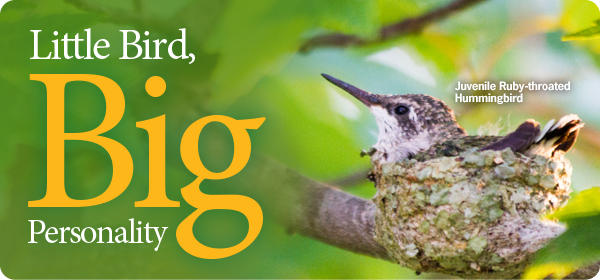
So Much to Know About Hummingbirds!
Hummingbirds are some of the most popular birds to visit our yards. And why not? These littlest jewels of the backyard have some of the biggest personalities.
Hummingbirds are indeed small, weighing 1/10th of an ounce; about the weight of a penny. They also lay the world’s smallest bird egg; about the size of a blueberry.
For such a little bird, hummingbirds can be very feisty and aggressive when defending their territories; which includes nectar feeders. Multiple feeders, spread throughout your yard, will encourage more hummingbirds to visit and keep bullies at bay. The more feeders you offer and the more spread out they are, the more difficult it is for a protective hummingbird to defend all the feeders. Others, like females or even juveniles, will be able to eat more often, perhaps staying longer to feed or rest at feeders.
Speaking of feeders, these little birds have big appetites. Hummingbirds eat about every ten minutes and their diet is not made up entirely of nectar. They spend more than 25% of their time foraging for small spiders and insects to obtain essential amino acids and other nutrients.
Hummingbird food is easy to make: Mix plain, white table sugar with water in a 1:4 ratio. One part sugar to four parts water. For example, mix 1/4 cup of sugar with 1 cup of water. Stir the mixture to dissolve the sugar. You may also boil the mixture to help the sugar dissolve, but make sure you let the mixture cool before you put it in the hummingbird feeder. We do NOT recommend adding any coloring to the nectar. Most hummingbird feeders are red, or mostly red, and that is plenty to attract the hummingbirds.
We also have powdered and liquid nectar mixes and ready-made nectar available in the store.
Hummingbirds use their bill and not their tongue to catch prey while they forage near the ground and in trees. They love spiders and spider eggs and keep an eye out for small flying insects like midges, fruit flies and gnats. They also check leaves and branches for leaf hoppers, aphids and even the occasional small caterpillar.
Our little hummingbirds are deceptively big on speed. They often seem to explode away from a feeder like a dragster. They typically fly at 30-45 miles per hour (48-72 kph), but can fly up to 60 mph (96 kph). They can even hover and are the only birds able to regularly fly backwards and even occasionally upside down. They can do this because of an extremely mobile shoulder joint.
Be a seasonally savvy bird feeder by installing multiple hummingbird nectar feeders around your yard to draw in these little birds with the big personalities. Visit our store and we'll help you pick out everything you need to attract hummingbirds to your backyard.

